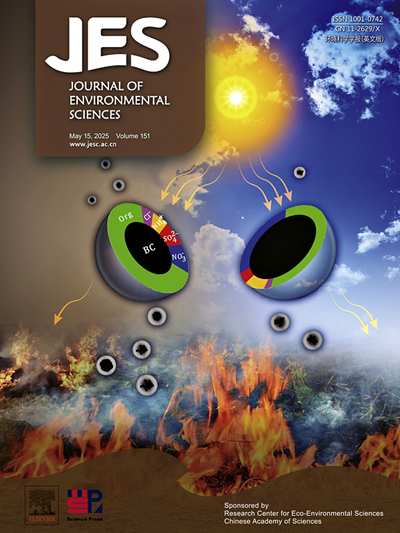Probabilistic ecological risk characterizing and source-specific risk apportionment of antibiotics in rivers in the sub-center of Beijing, China
IF 5.9
2区 环境科学与生态学
Q1 ENVIRONMENTAL SCIENCES
引用次数: 0
Abstract
The widespread occurrence of antibiotics in urban rivers has raised global concerns for ecological security. Quantitative source-specific risk apportionment of antibiotics is crucial for targeted and effective ecological risk management, but is rarely studied. In this study, a source-specific ecological risk apportionment model for antibiotics was developed by combining the ecological risk quotient (RQ) method and the positive matrix factorization (PMF) model. Based on twenty-two antibiotics in sixty-five water samples from thirteen sites in Beijing in wet and dry seasons, the spatial variation and probabilistic distribution of ecological risk associated with antibiotics were analyzed, and source-specific ecological risk was evaluated. Results showed that for the sum of all antibiotics, the mean concentration of all samples was 671.48 ng/L, and the lower limit of the 90 % confidence interval of RQs was more than ten times the threshold for the high-risk level. The main sources were identified as domestic sewage, pharmaceutical wastewater and livestock discharge. It should be noted that higher contributions to antibiotic concentrations from sources do not always result in higher levels of ecological risk. Domestic sewage and livestock discharge contributed roughly equivalent amounts (36.17 % and 37.59 %, respectively) to antibiotic concentrations. However, domestic sewage was the most dominant source for risk (63.30 %), and livestock discharge only contributed 7.37 % to risk. The study found that evaluating the source-specific ecological risk associated with antibiotics is essential in addition to identifying their sources. The source-specific ecological risk apportionment model developed in this study is also referential for related studies.

北京副中心地区河流抗生素的概率生态风险特征及源特异性风险分配
抗生素在城市河流中的广泛存在引起了全球对生态安全的关注。抗生素的定量来源风险分配对于有针对性和有效的生态风险管理至关重要,但很少研究。本研究将生态风险商(RQ)法与正矩阵分解(PMF)模型相结合,建立了抗生素源特异性生态风险分摊模型。以北京市13个站点65份水样中22种抗生素为研究对象,分析了水样中抗生素相关生态风险的空间变异和概率分布,并对水样中抗生素相关生态风险进行了源特异性评价。结果表明,所有抗生素样品的平均浓度之和为671.48 ng/L, RQs的90%置信区间下限大于高危水平阈值的10倍。主要污染源为生活污水、制药废水和牲畜排放。应该指出的是,来源对抗生素浓度的较高贡献并不总是导致更高水平的生态风险。生活污水和牲畜排放对抗生素浓度的贡献大致相当(分别为36.17%和37.59%)。其中,生活污水是最主要的风险来源(63.30%),牲畜排放仅占7.37%。该研究发现,除了确定抗生素的来源外,评估与抗生素相关的特定来源的生态风险也很重要。本研究建立的特定源生态风险分配模型对相关研究也具有一定的参考价值。
本文章由计算机程序翻译,如有差异,请以英文原文为准。
求助全文
约1分钟内获得全文
求助全文
来源期刊

Journal of Environmental Sciences-china
环境科学-环境科学
CiteScore
13.70
自引率
0.00%
发文量
6354
审稿时长
2.6 months
期刊介绍:
The Journal of Environmental Sciences is an international journal started in 1989. The journal is devoted to publish original, peer-reviewed research papers on main aspects of environmental sciences, such as environmental chemistry, environmental biology, ecology, geosciences and environmental physics. Appropriate subjects include basic and applied research on atmospheric, terrestrial and aquatic environments, pollution control and abatement technology, conservation of natural resources, environmental health and toxicology. Announcements of international environmental science meetings and other recent information are also included.
 求助内容:
求助内容: 应助结果提醒方式:
应助结果提醒方式:


